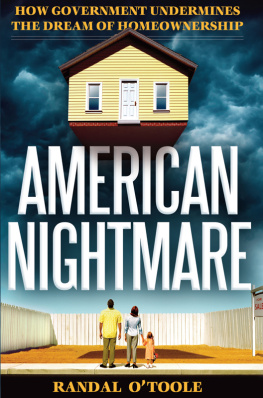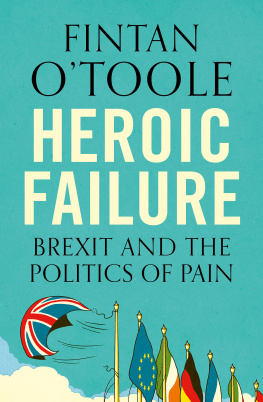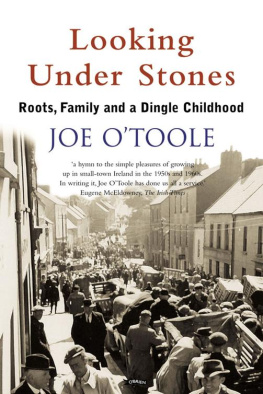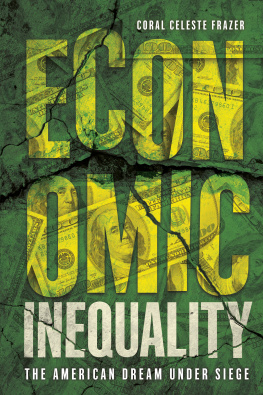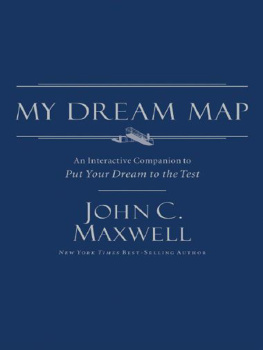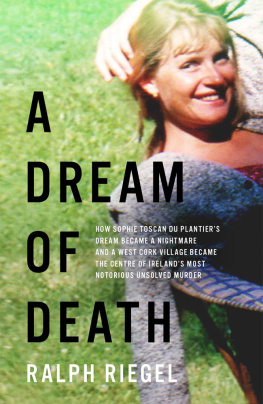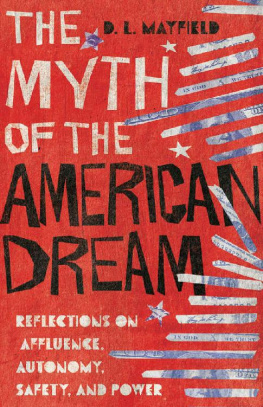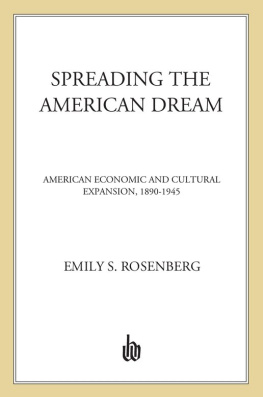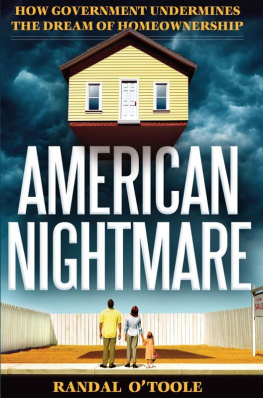Dedicated to the memory of my friend Chris Walker, whose work on land-use and transportation issues should inspire everyone who supports free markets and freedom of choice.
AMERICAN
NIGHTMARE
Along with millions of other Americans, I watched in shock and awe as the worlds financial markets melted down in September 2008. The knowledge that this was the beginning of a major recession was especially heartbreaking because several of my colleagues and I had been warning people of this imminent collapse, and ways to prevent it, for several years.
Numerous researchers have shown that government regulation has made American housing unnecessarily expensive and made many regional housing markets prone to bubbles. In recent years, the focus of state and local land-use regulation has been a war on sprawl that, in practice, became a war on single-family homes. Because 84 percent of people living in single-family homes own those homes, compared with just 14 percent of people living in multifamily housing, a war on single-family homes was a war on homeownership.
In 1997, for example, planners in my former hometown of Portland, Oregon, set a target of reducing the share of Portland-area households who lived in single-family detached homes from 68 percent in 1995 to 41 percent by 2040. If they are successful, hundreds of thousands of people who would have preferred single-family homes will be stuck in apartments instead. To achieve this goal, they limited the land available for new single-family homes while they used tax dollars to subsidize construction of multifamily dwellings. Similar plans have been or are being written for cities and metropolitan areas across the nation.
In places with relatively unregulated housing markets, housing is inexpensive, and when demand increaseswhether because of population growth, low interest rates, or loosened lending standards homebuilders build more homes. When new single-family homes are restricted, housing becomes expensive, and increases in demand lead to higher prices rather than more housing, while decreases in demand result in lower pricesin other words, a housing bubble.
The lesson I learned from the housing bubble was that the American dream of owning a single-family home is so powerful that many Americans will go to extraordinary lengths to achieve that dream, including dedicating more than half their incomes to 30-year mortgages on those homes. But many other people learned a very different lesson: the mantra they repeated over and over was As much as they might want to, some people shouldnt try to own their homes.
Homeownership has let us down, said Time magazine. The dark side of homeownership is now all too apparent: foreclosures and walkaways, neighborhoods plagued by abandoned properties and plummeting home values, a nation in which families have $6 trillion less in housing wealth than they did just three years ago.
Homeownership is overrated, says urban planner Richard Florida. Too many people in economically distressed communities are trapped in homes they cant sell, unable to move on to new centers of opportunity. Florida thinks more people should rent and that we should updat[e] our definition of the American dream.
Is the American dream of homeownership dead? In my opinion the American Dream as we know it is dead, wrote financial adviser Suze Orman. In many areas of the country, the dream of homeownership has backfired. Real estate values have deflated to such an extent that a record number of people owe more than their homes are worth.
American Nightmare explores the questions raised by the debate over homeownership. What is the right homeownership rate? Is universal homeownership possible or even desirable? What roles do the mortgage-interest deduction, Federal Housing Administration mortgage insurance, and other government housing programs play in influencing peoples decisions to buy rather than rent their homes? What are the real lessons of the housing-market crash? To answer these questions, this book looks at the history of home-ownership and its role in peoples lives and the economy as a whole.
As recently as 250 years ago, it is likely that fewer than 1 percent of the worlds families lived in their own homes. Even just 25 years ago, homeownership was a privilege enjoyed by only a small minority of people. Today, at least 60 percent of the worlds families own their own homes, and the percentage in many countries is much higher.
The United States was long a leader in this remarkable transformation. Throughout much of the 20th century, high U.S. homeownership rates contributed to the nations booming economy, encouraging other countries to remove local barriers to homeownership. But homeownership in this country may be little more than an accident of history. At the time the New World was being colonized, nearly everyone in Europe effectively rented their lands from their monarch, and many Dutch, French, and Spanish land grants in North America followed this pattern. But in 1629, King Charles I of England offered Massachusetts colonists fee simple landthat is, the opportunity to own land after paying a single fee rather than annual rents. Soon after the American Revolution, this form of land tenure became dominant in the United States, and Europeans, Asians, and others who wanted to own rather than rent land came to America for the opportunity to do so.
As late as the 1960s, Americas homeownership rate of more than 60 percent was one of the highest in the world. But at 65 percent today, America is barely in the middle of the pack. In the 60-some countries for which homeownership rates can be accurately determined, more than 75 percent of people live in their own homes. The fact that almost all those countries have lower per capita incomes than those in the United States flies in the face of the idea that American rates should be even lower because some people are too poor to afford a house.
Three different themes weave through American Nightmare s exploration of this history. First, homeownership provides many benefits, particularly for the children in homeowning families. Yet the main benefits of homeownership accrue to the homeowners and their families, so there is little reason for government to subsidize or otherwise promote homeownership. Instead, government should get out of the way and let people decide to buy or rent depending on their personal needs and the real costs of each of the alternatives. If this happens, the United States will likely end up with a higher rate of homeownership even if todays subsidies and political support for homeownership are eliminated.
Second, the recent financial crash did not result, as many believe, from a political effort to increase homeownership. Instead, it would be more accurate to say that the housing bubble and inevitable crash that followed resulted from a tension between federal policies aimed at increasing homeownership and state and local policies aimed at reducing homeownership. It would be even more accurate to say that the policies aimed at reducing homeownership caused the bubble, while some of the policies aimed at increasing it might have made the bubble worse than it otherwise would have been. But without the policies aimed at limiting homeownership, no housing bubble and no financial crisis would have occurred.
Finally, this book reveals that many of the superficially noble debates over housing, homeownership, and land use are really a form of class warfare in which members of the upper and middle classes attempt to shield their privileges, status, and lifestyles from the working and lower classes. One way of doing so is to promote policies that reduce homeownershippolicies that were an underlying cause of the recent financial crisis, yet are overlooked by writers and analysts who have looked at that crisis and made recommendations for preventing future crises. Unless states and cities reverse these anti-homeownership policies, more housing bubbles and crashes are inevitable.
Next page
